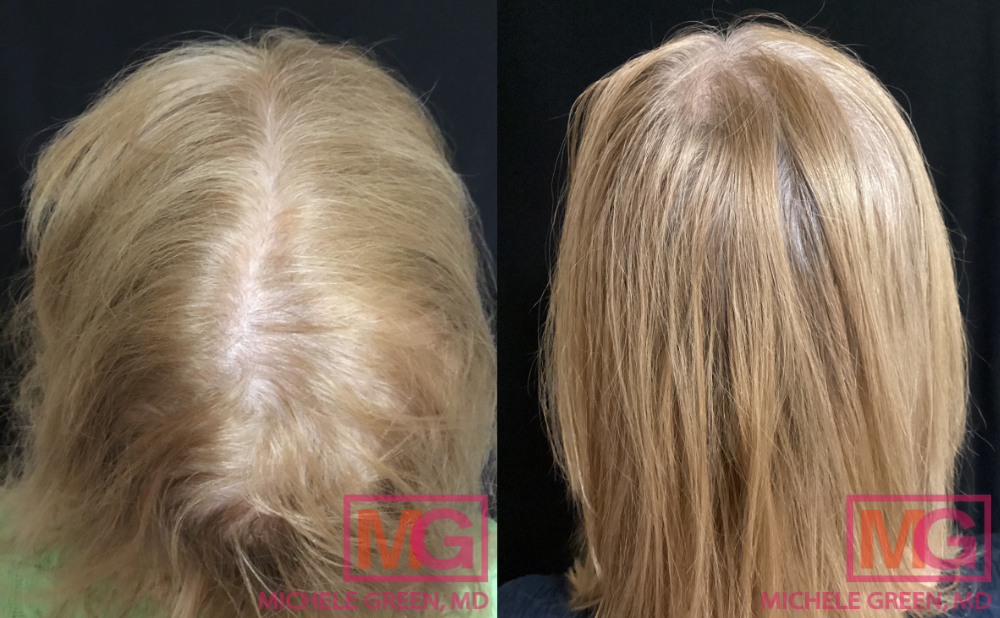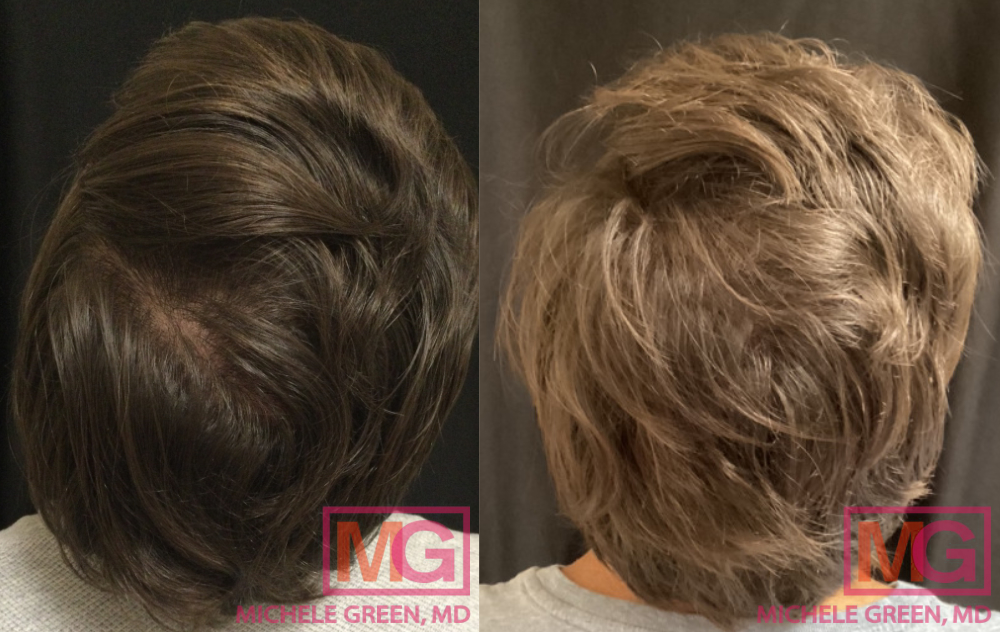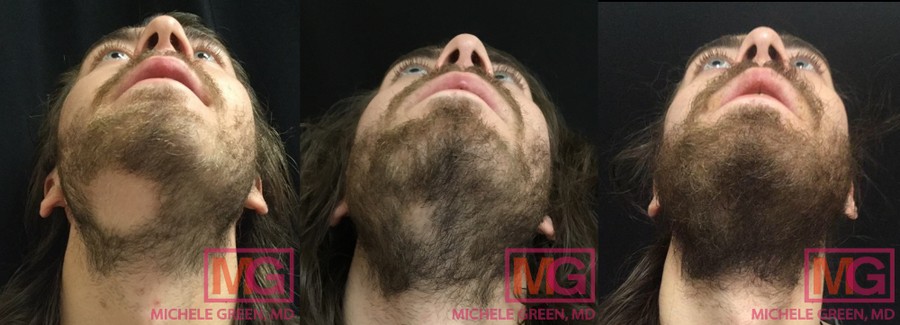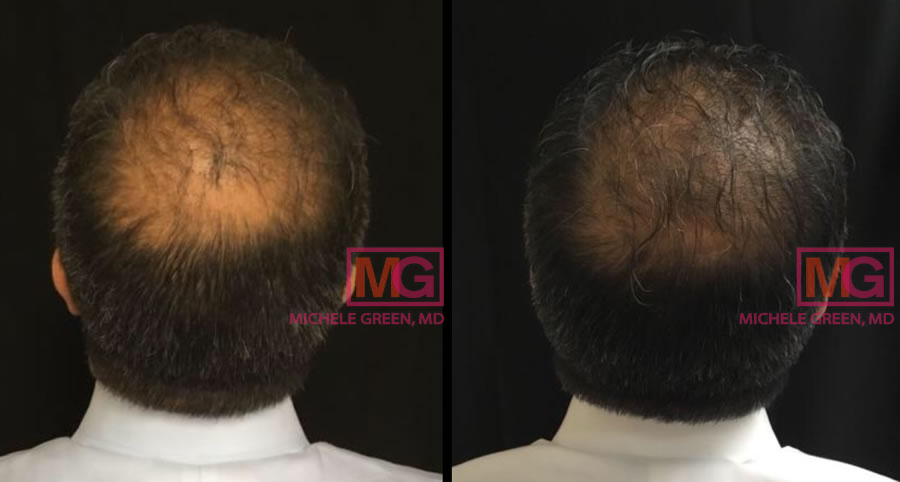Topical Minoxidil vs. Finasteride for Hair Loss
Hair loss can affect both men and women for several reasons. One common form of hair loss is androgenetic alopecia, which is caused by increased levels of androgen dihydrotestosterone (DHT) binding to the hair follicles on the scalp and destroying them. Male androgenetic alopecia, also known as male pattern baldness, is characterized by hair loss at the temples and crown of the head. At the same time, a widening of the part indicates female pattern hair loss as hair count decreases. Any form of hair loss can be highly distressing, causing patients to seek out the best treatment option. However, with so many oral medications, serums, and supplements on the market, it can be challenging to determine what is an effective treatment. When beginning your hair restoration journey, the best first step is to consult an expert healthcare provider, such as board-certified dermatologist Dr. Michele Green.
When treating hair loss, Dr. Green most frequently turns to two different medications: finasteride and minoxidil, which both increase hair growth and improve hair thickness for a healthier, fuller look. While these medications have similar results, they work very differently and can be used individually or together for even better results. Finasteride, also known by the brand name Propecia, blocks the enzyme responsible for DHT production, preventing DHT damage to hair follicles. Minoxidil, also known by the brand name Rogaine, works by increasing blood flow to the treatment area to improve new hair growth. Both minoxidil and finasteride can be applied topically or taken orally, depending on what will work best for your individualized treatment plan created by Dr. Green.
Experienced board-certified dermatologist Dr. Michele Green has been treating patients in her Upper East Side New York City dermatology office for more than 25 years. Available to treat various cosmetic and medical concerns, Dr. Green is an expert in Microneedling with PRP, Botox, dermal fillers, laser treatments, chemical peels, and much more. Dr. Green is highly familiar with different types of hair loss, which helps to determine the treatment option that will be most effective at creating new hair growth and preventing further hair loss. Well-known for high patient satisfaction, Dr. Green has been voted one of New York City’s top healthcare providers by such publications as New York Magazine, Castle Connolly, and Super Doctors.

What is the best hair loss treatment for androgenetic alopecia?
Androgenetic alopecia, or female or male pattern baldness, is a hair loss condition caused by hormone fluctuations. Androgenetic alopecia can affect both men and women, causing decreased hair density and hair loss over time. Male pattern hair loss typically occurs first along the temples, leading to the characteristic “M” shape of the hairline and on the crown of the head. In women, hair loss and thinning hair typically begin along the part, causing the part to become wider as hair count decreases. The condition occurs due to increased concentrations of the hormone dihydrotestosterone (DHT), which can bind to the hair follicles, impeding the anagen, or growth, phase of hair growth and preventing new hair growth. Luckily, there are many treatment options for female and male androgenetic alopecia that prevent hair loss and promote hair regrowth.
The best first step when seeking treatment for hair loss is to consult with an expert healthcare provider, such as dermatologist Dr. Michele Green. With so many options available to treat hair loss, it can be challenging to determine the most effective treatment to stop hair loss and trigger hair regrowth. Dr. Green is up-to-date on research that has received a systematic review, offering patients top-tier medical advice and treatment options that will be most effective. When dealing with androgenetic alopecia, Dr. Green will most frequently turn to finasteride to inhibit the conversion of testosterone into DHT or minoxidil as a vasodilator to encourage new hair growth.
What is oral Finasteride?
Finasteride is the generic name for the medication known as Propecia, which can be used to prevent hair loss and treat an enlarged prostate. Finasteride is a 5-alpha-reductase inhibitor, meaning that it acts as a DHT blocker, preventing the conversion of testosterone into DHT. When DHT levels become too high, the androgen can bind to the hair follicles, causing them to weaken, leading to hair loss and a decrease in new hair growth. Finasteride works well to prevent DHT levels from increasing, which prevents damage to the hair follicles. The medication is primarily available orally as a 1mg or 5mg tablet that should be taken daily for the best results. Typically, 1 mg tablets are used for hair loss as a higher dosage of the oral medication can lead to sexual side effects, such as decreased libido and erectile dysfunction. There is a topical solution of finasteride. However, unlike oral finasteride, topical finasteride does not have FDA approval to treat hair loss.
What is topical minoxidil?
Topical minoxidil, known also by the brand name Rogaine, is a topical treatment for hair loss conditions, such as androgenetic alopecia, telogen effluvium, and alopecia areata. The topical formulation of the minoxidil solution can be applied to the scalp to increase blood flow to the treatment area, which triggers and improves hair growth to combat hair loss conditions. Minoxidil was first prescribed to treat high blood pressure, but when hair growth was seen as a side effect of treatment, minoxidil was extensively studied and subsequently FDA-approved as a hair loss treatment. The medication works by widening blood vessels at the treatment area, which increases blood flow to the hair follicles, lengthening the anagen phase of hair growth and promoting thicker, healthier new hair. Topical minoxidil can be acquired over the counter as a dropper or a foaming solution that should be applied to the scalp once daily. Oral minoxidil is also an option for patients experiencing side effects of minoxidil topical solution, such as dermatitis and other skin irritation.

What are the side effects of Finasteride?
Oral finasteride can lead to sexual side effects in between 2 and 15% of patients, according to research published on the medication. As a DHT blocker, finasteride is designed to inhibit the formation of dihydrotestosterone and decrease DHT levels in the body. This can lead to side effects, including:
- Loss of libido
- Erectile dysfunction
- Decrease in volume of ejaculation
- Gynecomastia (the development of breast tissue in men)
- Higher risk of developing breast cancer
- Anxiety and depression
Patients are less likely to experience these sexual side effects with a lower dosage of finasteride (1 mg), which Dr. Green typically recommends to start treatment. Patients taking finasteride or minoxidil may experience increased hair loss during the first month of treatment, but this is an expected part of the treatment process. Hair count and regrowth should increase soon after.
Based on a randomized, comparative study, which is better: Minoxidil or Finasteride?
Authors Arca et al. published a randomized, comparative study (DOI: 10.1159/000079595) appearing on PubMed.gov in which they looked at the effectiveness of oral finasteride and topical minoxidil at increasing hair count and the severity of adverse events. Researchers found that at the end of the study, 80% of the patients who received oral finasteride experienced higher hair density compared to 52% of patients who were prescribed 5% topical minoxidil. The patients taking oral finasteride were more likely to experience side effects, with 15% experiencing loss of libido during treatment, compared to 4% who experienced skin irritation when applying topical minoxidil. These side effects were generally considered mild, however, and did not prevent patients from finishing the study. Adverse events disappeared when treatment was over. The study demonstrated that both topical minoxidil and oral finasteride are safe and effective at promoting hair regrowth.
Is minoxidil better than Finasteride for regrowth?
Minoxidil and finasteride are effective treatments for hair regrowth but work very differently to promote new hair growth. Finasteride is a 5-alpha-reductase inhibitor that works to decrease levels of DHT, hormones that are damaging to hair follicles. This makes finasteride specifically very useful in treating male androgenetic alopecia, which is caused by increased DHT levels in the body. Studies show that taking oral finasteride for an extended amount of time can decrease symptoms of androgenetic alopecia and improve hair growth in 90% of patients. Finasteride is typically not the best option for pre-menopausal women in treating female pattern baldness, as modifying hormone levels with finasteride can interfere with birth control and can be dangerous for women who are pregnant or breastfeeding. Oral finasteride is also associated with sexual side effects for men, including erectile dysfunction and loss of libido.
Minoxidil works as a vasodilator, increasing the size of blood vessels to improve blood flow to the treatment area. Studies have shown that, compared with a placebo, minoxidil significantly improves hair count when used over time. One advantage of topical minoxidil is that it can be used for various types of hair loss – not just androgenetic alopecia – and it does not interfere with hormones, meaning that pre-menopausal women can use it without worrying about the medication interfering with birth control. Women who are pregnant or breastfeeding should still avoid minoxidil to reduce the risk of harm to the fetus. Minoxidil is not associated with any sexual side effects and can be used as an alternative to finasteride for men experiencing unwanted sexual side effects.
Is topical minoxidil and Finasteride better together?
Because they work very differently, topical minoxidil and oral finasteride can be used together quite effectively. Studies have shown that combining topical minoxidil and oral finasteride gives patients better results than if either medication is taken alone. Another study demonstrated that following 8-12 months of oral finasteride treatment, 5% topical minoxidil can be combined with 0.1% topical finasteride to help maintain hair growth and density, which is an excellent option for patients who do not want to continue taking oral finasteride indefinitely. When you have your initial consultation with Dr. Green at her Upper East Side dermatology office, she will recommend which treatment option or combination of treatments will work best for you.
Is Finasteride minoxidil topical better than oral?
Both minoxidil and finasteride have topical and oral options for medication. No one treatment option is inherently “better” than the other. Instead, they serve different purposes and can provide patients with slightly different results. One advantage of oral minoxidil and oral finasteride is that it is usually easier for patients to take a pill rather than apply a topical solution to their head. With oral medication, there is no hair color change or residue that patients must deal with following application.
Additionally, topical finasteride and minoxidil can cause localized skin irritation on the scalp, itching, and scaly skin. Oral finasteride can cause some frustrating side effects, such as decreased sex drive and erectile dysfunction, which can be avoided with a topical treatment. Before beginning hair regrowth treatment, it is essential to seek medical advice from a healthcare professional such as Dr. Green, who can recommend the treatment option that will work best for you.

What are the pros and cons of topical Finasteride?
Topical finasteride is now available. However, it has not yet been FDA-approved for hair loss, nor has it been as extensively studied as oral finasteride or topical minoxidil. Studies are beginning to emerge, demonstrating that topical finasteride and topical minoxidil can be paired together for long-term maintenance of hair density after oral finasteride treatment. One pro of topical finasteride treatment compared to oral finasteride is that the risk of developing sexual side effects is much lower from topical finasteride, which is localized to the scalp. Conversely, patients are more likely to experience side effects, such as scalp irritation, dryness, flakiness, and hair color change. When determining what type of hair loss treatment is best for you, it is essential to discuss the pros and cons of each form of treatment with your healthcare provider and find the treatment method that will promote the highest compliance.
Why topical Finasteride is better
Topical finasteride has not yet been FDA-approved to treat hair loss, and there are fewer studies available discussing the safety and efficacy of the treatment. When creating a treatment plan for her hair loss patients, Dr. Green typically turns to topical minoxidil, oral minoxidil, or oral finasteride. Dr. Green may pair a low topical finasteride dosage with topical minoxidil for improved new hair growth results.
Is topical Finasteride just as good as oral Finasteride?
While fewer studies have been completed demonstrating the effectiveness of topical finasteride, both topical and oral finasteride have been shown to improve hair growth. According to clinical studies, topical finasteride has been shown to increase hair growth significantly compared to a placebo. Several studies have demonstrated that oral finasteride is highly effective in improving hair regrowth, with as many as 90% of patients experiencing improvement throughout the study. One large-scale study performed in Japan found that 36% of men saw moderate hair regrowth during the treatment process, and 11% saw significant hair regrowth. While there are some advantages of topical solutions over oral medication, generally speaking, oral medication, such as oral finasteride, is going to be more effective at promoting hair regrowth and preventing hair loss.
Does Finasteride lower testosterone?
Many forms of testosterone are found in the body, ranging from free testosterone to testosterone that binds to proteins or other receptors. Neither high levels of testosterone nor low levels of testosterone are directly related to hair loss or hair density. Testosterone can be converted into dihydrotestosterone (DHT), which contributes directly to hair loss by damaging hair follicles on the scalp, leading to male pattern baldness. Higher testosterone levels may mean that testosterone is converted to DHT at higher rates, which can affect hair loss. Finasteride is a DHT blocker, meaning that it prevents testosterone from being converted into DHT. Finasteride does not affect testosterone levels. Instead, it inhibits only the enzyme responsible for converting testosterone to DHT.
How much DHT does topical finasteride block?
Finasteride works to block the conversion of testosterone into dihydrotestosterone, which is an androgen responsible for hair loss. Dihydrotestosterone, or DHT, binds to hair follicles, causing damage and reducing hair growth. By blocking the formation of DHT, finasteride prevents hair loss from occurring and helps to promote new hair growth. In a study performed on 23 men taking either oral finasteride or topical finasteride, researchers found that DHT levels were lowered by between 68 and 75% for men applying topical finasteride compared to DHT levels reduced by between 62 and 72% for men taking oral finasteride. DHT levels are comparably lowered between oral and topical finasteride, preventing hair loss from occurring and promoting new hair growth.
Does topical finasteride block all DHT?
Topical finasteride is applied to the scalp, either as a serum or a foam. Typically, male androgenetic alopecia begins with thinning at the temples and the top of the head, forming a characteristic “M” shape of the hairline. As the condition advances, hair loss continues on the top of the head until all that remains is hair along the sides and back of the head. Topical finasteride can help by blocking DHT, responsible for hair loss. The medication does not block all DHT but can block between 68 and 75% of DHT, slowing the hair loss and allowing new hair to grow.
Does Finasteride thicken hair?
Oral finasteride is one of the most commonly used treatment options for male pattern baldness, a condition that can affect as many as two out of every three men before the age of 35. Hair loss can occur due to high levels of dihydrotestosterone binding to hair follicles and destroying them. Finasteride works to inhibit the formation of dihydrotestosterone, restoring lost hair and allowing for new hair growth. As a result, the hair appears thicker and fuller than before. Oral finasteride can significantly slow the rate of hair loss, prolonging thick, healthy-looking hair.
Is there a better option than Finasteride?
Finasteride is a highly effective treatment for hair loss in the form of androgenetic alopecia, also known as male pattern baldness. Androgenetic alopecia is caused by increased levels of dihydrotestosterone in the body, an androgen that binds to hair follicles and damages them. Finasteride works to reduce DHT levels by inhibiting the enzyme that changes testosterone to DHT and is highly effective at improving hair count and growth in men experiencing male pattern baldness. Finasteride is not the best option for other forms of hair loss that occur for reasons other than hormone fluctuations. For other forms of hair loss, Dr. Green will most often turn to either oral or topical minoxidil, which is why it is essential to understand the underlying cause of hair loss before seeking treatment.
Can I switch from minoxidil to Finasteride?
Minoxidil and finasteride are safe and effective treatment options for hair loss, which can be used individually or combined for increased efficacy. Depending on your specific needs, Dr. Green may begin treatment with topical minoxidil. Oral finasteride and oral minoxidil are typically more powerful treatment options, and, as such, Dr. Green may switch to one of those options if a topical treatment on its own is not providing patients with the most desirable results.

Does minoxidil work on frontal baldness?
One of the early symptoms of male androgenetic alopecia is thinning hair at the temples, creating a frontal baldness and receding hairline. For many men, a receding hairline can begin to form in their late 20s and early 30s, providing a source of frustration or self-consciousness. One highly effective treatment option is minoxidil for frontal baldness. Minoxidil can be consumed orally or applied topically to the treatment area, increasing blood flow to promote new hair growth and thicker, healthier hair follicles.
What are the cons of minoxidil and Finasteride?
Minoxidil and finasteride are both safe and effective treatment options for hair loss. Neither treatment is associated with significant side effects, and in many studies, patients who experienced mild side effects did not feel the need to stop treatment. For topical minoxidil and topical finasteride, patients may experience dryness and irritation on the scalp due to applying the topical solution. Oral finasteride can cause sexual side effects, such as erectile dysfunction and loss of libido. To discover which hair loss treatment option will work best for you, schedule a consultation with expert, board-certified dermatologist Dr. Michele Green.
Is minoxidil pointless without Finasteride?
Topical minoxidil can be used as a treatment or paired with oral finasteride. Both treatments serve different functions, with finasteride blocking the formation of DHT and minoxidil increasing blood flow to increase hair growth. Studies have shown that while both treatment options are effective individually, they are even more effective when paired. Not everyone needs both medications to achieve their desired results, however, so Dr. Green will examine the treatment area, determine the underlying cause of hair loss, and then decide about the treatment plan that will be best for you.
How do I get started with hair loss treatment today?
Hair loss can be an extremely distressing condition for men and women dealing with androgenetic alopecia caused by changes in hormone levels. Testosterone converted into dihydrotestosterone (DHT) can wreak havoc on hair follicles, causing damage and preventing hair growth. With so many hair loss treatment options being advertised, from medications to supplements to serums, it can be challenging to know what treatment options are safe and effective. That is why it is essential to start your treatment journey by consulting an expert, board-certified dermatologist, such as Dr. Michele Green. With years of treating patients with all forms of hair loss, Dr. Green is highly experienced with creating plans that will work best for your individual needs. The best place to start is by consulting with a board-certified dermatologist, such as Dr. Michele Green.
Dr. Michele Green is an internationally renowned board-certified dermatologist with over two and a half decades of experience creating customized treatment plans for her patients from around the globe, including treating hair loss. Dr. Green takes a holistic approach to hair regrowth, and she is consistently identified as one of New York City’s best healthcare professionals by Castle Connolly, New York Magazine, and Super Doctors for her dedication to her patients and expertise. When you consult with Dr. Green, she will work with you to develop a personalized treatment plan for your hair loss to provide you with thicker, healthier hair that lasts. Please get in touch with us online or call 212-535-3088 to learn more about how minoxidil and finasteride can treat your hair loss.
 212-535-3088
212-535-3088